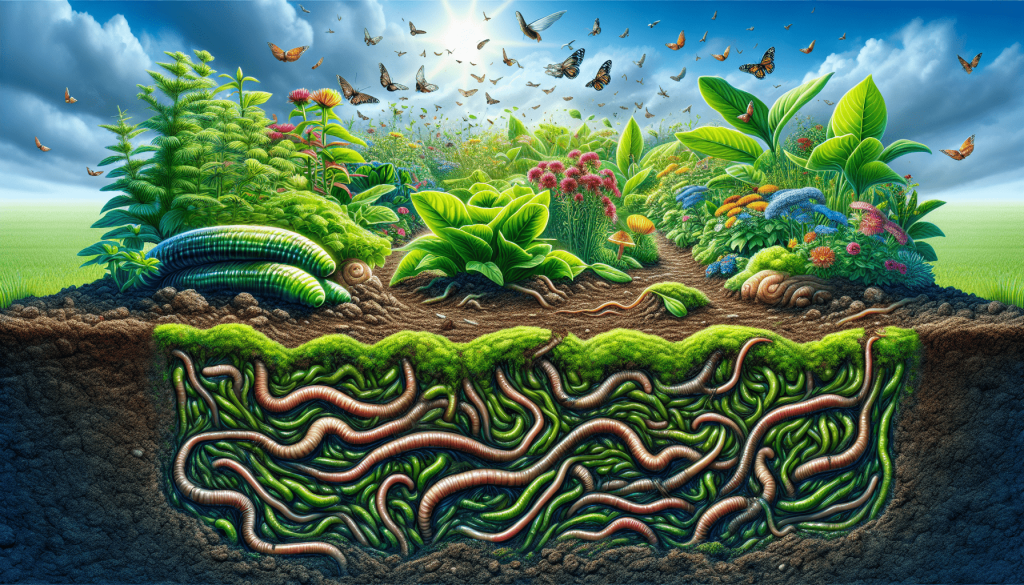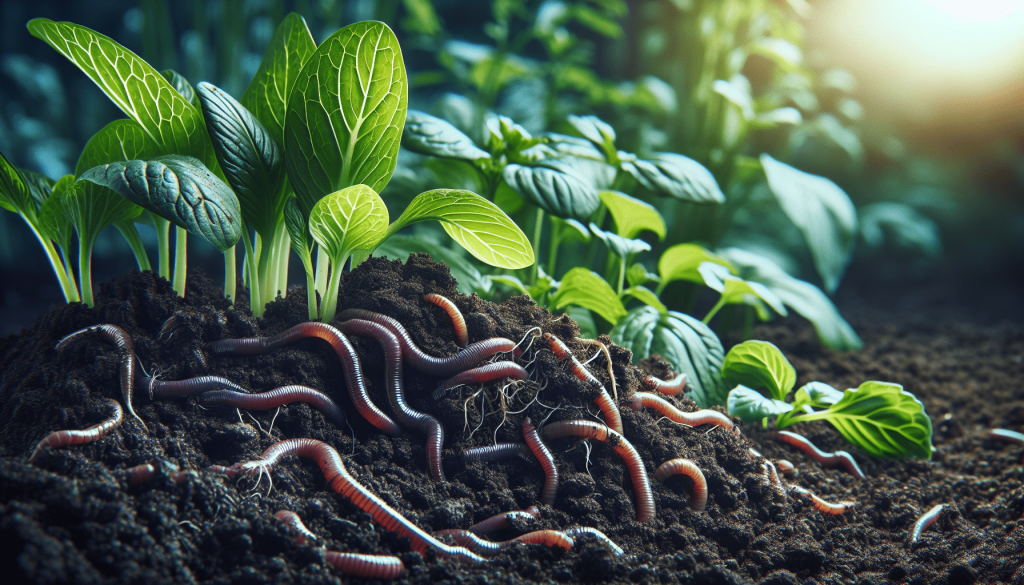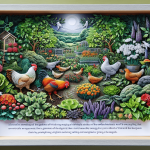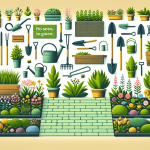This post may contain affiliate links. As an Amazon Associate, we may earn commissions from qualifying purchases.
You’re in for a treat with Exploring The Benefits Of Integrating Vermiculture Into Garden Systems. This article delves into the fascinating world of vermiculture, uncovering how the use of worms can transform your gardening experience. From enriching soil to reducing waste, you’ll discover the multitude of benefits that come with incorporating these industrious creatures into your garden setup. Prepare to be amazed at how vermiculture can elevate your green thumb efforts and yield impressive results. Have you ever wondered how you can boost your garden’s health while being eco-friendly? Integrating vermiculture into garden systems might be the solution you’re looking for! This friendly guide will walk you through the numerous benefits of incorporating vermiculture—using worms to decompose organic waste—into your gardening routine.
What is Vermiculture?
Vermiculture, or worm farming, involves the use of earthworms to convert organic waste into nutrient-rich compost. This compost, known as vermicompost or worm castings, is incredibly beneficial for plant health and soil quality. Vermiculture is an efficient, sustainable, and environmentally-friendly way to manage organic waste in your garden.
The Science Behind Vermiculture
In vermiculture, specific types of worms, usually red wigglers or tiger worms, are used to break down organic material. These worms consume organic waste and produce vermicast, a finer and more nutrient-dense fertilizer than traditional compost.
Benefits of Vermiculture in Garden Systems
Integrating vermiculture into your garden can have numerous benefits, both for your plants and the environment. Here are some compelling reasons to start a vermiculture system.
Improves Soil Health
Vermiculture significantly enhances soil structure and fertility. Worm castings are packed with nutrients essential for plant growth, including nitrogen, phosphorus, and potassium. These nutrients are readily available for plant roots, ensuring optimal growth and productivity.
Boosts Plant Growth
The rich nutrient profile and beneficial microbes present in vermicast can accelerate plant growth, making plants healthier and more resistant to diseases.
Enhances Water Retention
Vermicast improves soil’s water-holding capacity. It helps maintain moisture levels, reducing the need for frequent watering and conserving water resources.
Reduces Waste
By composting kitchen scraps and garden waste, vermiculture reduces the amount of organic waste that ends up in landfills. This not only lowers your waste management costs but also decreases the environmental impact of waste disposal.
Eco-Friendly Solution
Vermiculture is a natural, eco-friendly method of recycling organic waste. It produces little to no greenhouse gases compared to traditional composting methods.
Easy to Maintain
A vermiculture setup doesn’t require much space or time to maintain. Once your worm bin is established, the worms do most of the work!

How to Integrate Vermiculture into Your Garden System
Now that you’re aware of the benefits, let’s get practical. Here’s how you can incorporate vermiculture into your garden system.
Setting Up Your Worm Bin
You can start small with a simple worm bin. Here’s how:
- Choose a Bin: Select a bin with a lid. Plastic storage bins or wooden boxes work well.
- Create Ventilation: Drill small holes in the lid and sides for airflow.
- Prepare Bedding: Add shredded newspaper, cardboard, and a bit of soil to the bin.
- Moisten Bedding: Slightly dampen the bedding material with water.
- Add Worms: Introduce red wigglers or tiger worms to the bin.
- Add Waste: Start adding household waste like vegetable scraps, coffee grounds, and crushed eggshells.
Feeding Your Worms
Worms have specific dietary needs. Here’s a list of what to feed them and what to avoid:
| Feeds | Avoids |
|---|---|
| Fruit and vegetable scraps | Meat, dairy, and oily foods |
| Coffee grounds and filters | Citrus peels |
| Crushed eggshells | Spicy and salty foods |
| Shredded paper | Plastic or synthetic materials |
Harvesting Vermicast
After a few months, your worms will produce vermicast. To harvest:
- Move Worms: Push contents to one side of the bin and add fresh bedding and waste to the empty side.
- Wait: Wait a week or so for the worms to migrate to the new side.
- Collect Vermicast: Collect the finished compost from the old side.
Using Vermicast in Your Garden
You can use vermicast in several ways:
Top Dressing
Simply spread the vermicast on top of your garden beds and around plants to enrich the soil.
Soil Amendment
Mix vermicast with your garden soil to improve fertility and structure before planting.
Compost Tea
Make a “compost tea” by steeping vermicast in water. This liquid fertilizer can be used for watering plants to provide them with a nutrient boost.
Advanced Vermiculture Techniques
Once you’ve mastered the basics, you might want to explore more advanced vermiculture techniques.
Vermicomposting Toilets
These eco-friendly toilets use worms to break down human waste into compost. They are particularly useful in off-grid settings or sustainable living projects.
Worm Towers
Worm towers are tubes buried in garden beds, where kitchen waste is added and worms enter to compost. This method integrates vermiculture directly into garden beds.

Common Challenges and Solutions
Like any gardening method, vermiculture comes with its own set of challenges. Here’s how to tackle them:
Odor Issues
Problem: If your worm bin starts to smell, it could be due to overfeeding or improper ventilation.
Solution: Reduce feeding quantities and ensure proper airflow. Avoid adding too many acidic or oily foods.
Worms Escaping
Problem: Worms might try to leave the bin if conditions are not ideal.
Solution: Check moisture levels, temperature, and food supply. Maintain a cool, moist, and dark environment.
Pests
Problem: Fruit flies and other pests can become a nuisance.
Solution: Bury food scraps under bedding and cover the bin with a well-fitted lid. Consider using a fruit fly trap.
Incomplete Composting
Problem: You may find that the compost isn’t breaking down fully.
Solution: Chop waste into smaller pieces for faster decomposition and ensure a balanced feeding regimen.
Comparing Vermiculture with Traditional Composting
Wondering how vermiculture stacks up against traditional composting? Here’s a quick comparison:
| Aspect | Vermiculture | Traditional Composting |
|---|---|---|
| Speed | Faster | Slower |
| Nutrients | Higher nutrient content | Lower nutrient content |
| Space | Requires less space | Requires more space |
| Maintenance | Lower maintenance | Higher maintenance |
| Odor | Little to no odor | Can produce aerobic odors |
Vermiculture for Urban Gardens
Don’t have a backyard? No problem! Vermiculture is perfect for urban gardeners. Small worm bins can fit in apartments, balconies, or even under the kitchen sink.
Indoor Vermiculture
Use a compact, odor-free worm bin for indoor composting. This is an excellent way to manage kitchen scraps in limited spaces while producing fertilizer for houseplants or balcony gardens.
Community Gardens
Community garden projects can benefit from collective vermiculture systems. Shared worm bins can manage larger amounts of waste and produce ample compost for shared garden plots.
Environmental Impact of Vermiculture
Vermiculture isn’t just good for your garden—it’s beneficial for the planet, too. Let’s take a look at the broader environmental impacts:
Reduces Carbon Footprint
By diverting organic waste from landfills, vermiculture reduces methane emissions—a potent greenhouse gas. This practice helps combat climate change.
Conserves Resources
Producing vermicast at home minimizes the need for chemical fertilizers, reducing pollution and conserving water resources.
Promotes Biodiversity
Healthy vermiculture systems support diverse microbial life, promoting soil health and ecological balance.
Real-Life Success Stories
Hearing about others’ successes can be inspiring. Here are a few examples of effective vermiculture integration:
Urban Farmer Alex
Alex, an urban farmer, uses vermiculture on his small rooftop garden. By composting kitchen scraps, he’s enriched his soil and boosted vegetable yields, all while reducing his waste footprint.
Community Garden Project
A local community garden implemented a shared vermiculture system. Participants bring their organic waste, and the resulting vermicast is used for communal garden beds. The project has thrived, with healthier plants and lower waste management costs.
Tips for Beginner Vermiculturists
Ready to start your vermiculture journey? Here are some tips:
Start Small
Begin with a small bin and gradually expand as you gain confidence.
Monitor Conditions
Regularly check moisture levels, temperature, and ventilation to keep worms happy.
Educate Yourself
Join online forums or local workshops to learn from experienced vermiculturists.
Be Patient
Worms need time to adjust and start producing vermicast. Give your system a few months to become fully operational.
Conclusion
Exploring the benefits of integrating vermiculture into garden systems reveals a wealth of advantages for both gardeners and the environment. From improved soil health and plant growth to reduced waste and environmental impact, vermiculture is a sustainable and rewarding practice. By following the steps and tips outlined in this guide, you can start your own vermiculture system and contribute to a greener, healthier world.
Happy worm farming!







